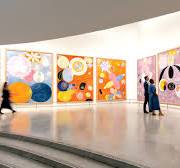Not knowing where to start with this blog post, let's begin with a direct quote from the horse’s mouth:
“For over four decades, Quilt National has showcased the best in contemporary quiltmaking, pushing the boundaries of tradition while celebrating creativity, technical mastery, and artistic expression. This year, jurors Ellen Blalock, LUKE Haynes, and Martha Sielman selected 84 quilts that represent a bold and diverse array of styles and themes.” - from https://dairybarn.org/quilt-national-25
This is the big deal of shows for quilt artists, one for which the artistic merits and impact of a piece are everything. Technical excellence is important too, but that is just a requirement to get in the door!
So I’m beyond excited to say after a couple of failed attempts, my piece “The King Family” was accepted into Quilt National 2025.
Road Trip!
As in the past, Quilt National starts out with Spring-Summer exhibition at the Dairy Barn in Athens, Ohio, which happens to be an eight-or-so hour drive from our home just north of Toronto. My husband and I drove down for the opening festivities, and we were delighted to meet so many other artists, sponsors and organizers.
Art Cloth Network was well represented, with three of our members having pieces in the show (more about that later).
There were multiple events to attend in a well-planned weekend of activities, starting with an “artists-only” preview on Friday, May 23. This was a great opportunity to meet up with old and new friends and see the artwork quietly. Afterwards the public started arriving and you could feel the excitement mount as the crowd got bigger and louder, until the moment the awards were presented. This year’s Best of Show was the beautiful “Veriditas” by Shin-Hee Chin, one of four purchase awards designed to permit the International Quilt Museum to acquire some of the best quilted artwork from around the world on an ongoing basis. Much has been written about this year’s award-winners, so I leave you to check these out on social media if you want to know more.
At the banquet later that evening there was more opportunity to meet other artists and make new friends.
On Saturday morning we had another artist-only event, during which each artist talked for a few minutes about their work. This was one of the highlights of the weekend.
I imagined a family of king penguins, leaders in their community, going to a goldsmith to order a custom frame. Of course they want to emphasize that they are kings, so the frame is made of very ornate goldwork, topped by a crown with a squid motif. Instead of the lions rampant that a human family may have on its crest, this family has gone with skuas and orcas, both frightening beasts when you’re a penguin! And of course it needs a motto in Latin (it means “the early bird catches the fish”). Generations of the king penguin family fill the photo ovals, including some young ones on the bottom row.
Here's Russ Little looking very proud (and rightly so!) with his piece "More than Black & White #4". Russ had this to say about it:
"It's part of a short series. The genesis of it was to focus on compositions that really concentrated on value and less on hue, and saturation. As things would happen, the first couple of them were very monochromatic and then colour started creeping in more and more and more. But from a life experience perspective it was during the Black Lives Matter protests in the summer. There was s lot going on in our lives, a lot going on in the world, and the phrase that kept rattling around in my head was 'There's more to this than black and white'."
And here's Barbara Schneider talking to the assembled artists about her piece.
"This is 'Forest Floor, Tree Bark Fragments, var.10’. The basis of my work with the fragments is to make the small, inconsequential things I find while walking in the forest more visible and intriguing. I enlarge the imagery and show the beauty of things that are ephemeral and ignored. These were bits and pieces that came off a plane tree. They had a curve of their own and holes and markings, and I wanted to make them larger and try to capture that sense of undulation and connection between the pieces. I print photos of the bark on fabric and do a lot of stitching. They are stiffened to create dimension. Each one was done individually, and I arrange them to get the shadows and create relationship between pieces. I do a lot of work in the conservation district. This is a way for me to connect those two parts of my life."
On Saturday all the artists participated in a group photo.
Saturday finished off with a casual dinner/meetup with artists, sponsors and friends at a local winery. At that event the Art Cloth Network folks sat together for a little catching-up time before the long drive home on Sunday.
The Art Cloth Network members and spouses present at the event, from left to right: Sue Sherman, Sue's husband Don McCuaig, Barbara Schneider, Russ's husband Dan Ryan, Russ Little, Kathleen Cunningham.
































